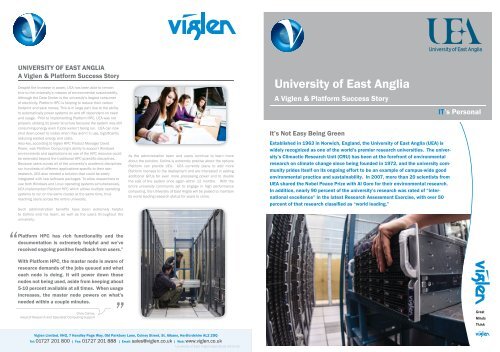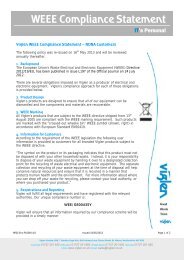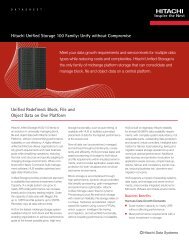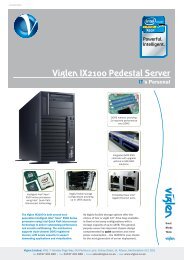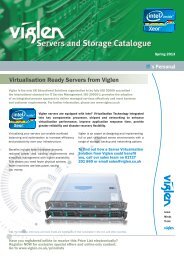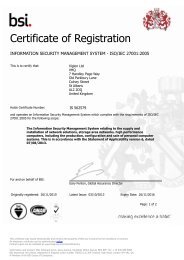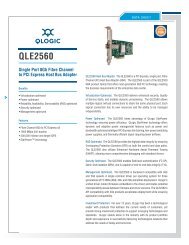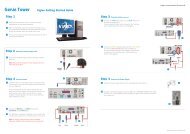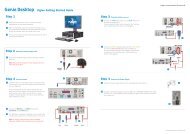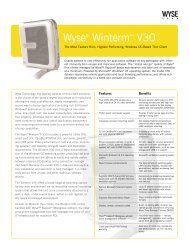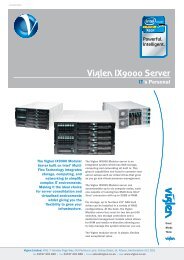University of East Anglia Case Study 2012-02.indd - Viglen
University of East Anglia Case Study 2012-02.indd - Viglen
University of East Anglia Case Study 2012-02.indd - Viglen
- No tags were found...
Create successful ePaper yourself
Turn your PDF publications into a flip-book with our unique Google optimized e-Paper software.
UNIVERSITY OF EAST ANGLIAA <strong>Viglen</strong> & Platform Success StoryDespite the increase in power, UEA has been able to remaintrue to the university’s mission <strong>of</strong> environmental sustainability.Although the Data Center is the university’s largest consumer<strong>of</strong> electricity, Platform HPC is helping to reduce their carbonfootprint and save money. This is in large part due to the abilityto automatically power systems on and <strong>of</strong>f dependent on needand usage. Prior to implementing Platform HPC, UEA was notproperly utilising its power structure because the system was stillconsuming energy even if jobs weren’t being run. UEA can nowshut down power to nodes when they aren’t in use, signifi cantlyreducing wasted energy and costs.Also key, according to <strong>Viglen</strong> HPC Product Manager DavidPower, was Platform Computing’s ability to support Windowsenvironments and applications so use <strong>of</strong> the HPC resource couldbe extended beyond the traditional HPC scientifi c disciplines.Because users across all <strong>of</strong> the university’s academic disciplinesrun hundreds <strong>of</strong> different applications specifi c to their ownresearch, UEA also needed a solution that could be easilyintegrated with new s<strong>of</strong>tware packages. To allow researchers touse both Windows and Linux operating systems simultaneously,UEA implemented Platform HPC which allows multiple operatingsystems to run on the same cluster at the same time, thusreaching users across the entire university.Such administration benefi ts have been extremely helpfulto Collins and his team, as well as the users throughout theuniversity.As the administration team and users continue to learn moreabout the solution, Collins is extremely positive about the optionsPlatform can provide UEA. UEA currently plans to add morePlatform licenses to the deployment and are interested in addingadditional GPUs for even more processing power and to doublethe size <strong>of</strong> the system once again within 12 months. With theentire university community set to engage in high performancecomputing, the <strong>University</strong> <strong>of</strong> <strong>East</strong> <strong>Anglia</strong> will be poised to maintainits world leading research status for years to come.<strong>University</strong> <strong>of</strong> <strong>East</strong> <strong>Anglia</strong>A <strong>Viglen</strong> & Platform Success StoryIt’s Not Easy Being GreenEstablished in 1963 in Norwich, England, the <strong>University</strong> <strong>of</strong> <strong>East</strong> <strong>Anglia</strong> (UEA) iswidely recognized as one <strong>of</strong> the world’s premier research universities. The university’sClimactic Research Unit (CRU) has been at the forefront <strong>of</strong> environmentalresearch on climate change since being founded in 1972, and the university communityprides itself on its ongoing effort to be an example <strong>of</strong> campus-wide goodenvironmental practice and sustainability. In 2007, more than 20 scientists fromUEA shared the Nobel Peace Prize with Al Gore for their environmental research.In addition, nearly 90 percent <strong>of</strong> the university’s research was rated <strong>of</strong> “internationalexcellence” in the latest Research Assessment Exercise, with over 50percent <strong>of</strong> that research classified as “world leading.”IT’s Personal“Platform HPC has rich functionality and thedocumentation is extremely helpful and we’vereceived ongoing positive feedback from users.”With Platform HPC, the master node is aware <strong>of</strong>resource demands <strong>of</strong> the jobs queued and whateach node is doing. It will power down thosenodes not being used, aside from keeping about5-10 percent available at all times. When usageincreases, the master node powers on what’sneeded within a couple minutes.”Chris Collins,Head <strong>of</strong> Research and Specialist Computing Support<strong>Viglen</strong> Limited, VHQ, 7 Handley Page Way, Old Parkbury Lane, Colney Street, St. Albans, Hertfordshire AL2 2DQTel: 01727 201 800 | Fax: 01727 201 888 | Email: sales@viglen.co.uk | Web: www.viglen.co.uk<strong>University</strong> <strong>of</strong> <strong>East</strong> <strong>Anglia</strong> <strong>Case</strong> <strong>Study</strong> <strong>2012</strong>-02
VIGLEN HIGH PERFORMANCE COMPUTINGUNIVERSITY OF EAST ANGLIAA <strong>Viglen</strong> & Platform Success StoryThe ChallengesExtending HPC beyond the SciencesPowering Up to Power Down• Create a “green” HPC resource that aligned with the university’sleading edge research in climatology and environmental studies• Find a user-friendly solution, easily accessible to academics andstudents across the entire university• Expand HPC usage beyond scientifi c disciplines to researchersin the arts and humanities• Increase compute power in an effi cient manner with the abilityto automatically power systems on and <strong>of</strong>f dependent onjob schedules• Support for research across multiple operating systems,including both Windows and LinuxThe SolutionPlatform HPC management s<strong>of</strong>twareWith such a heavy focus on research, high performance computing(HPC) has been an integral part <strong>of</strong> the university for the past tenyears, with the campus running its own dedicated general purposeHPC facility. The HPC resource has traditionally supported researchwithin the scientifi c disciplines, such as the university’s climateand environmental research and chemistry, computer scienceand mathematics departments. But as the university’s researchdemands grew, so did their need for compute power. The systemthey had in place was no longer able to keep up with the sciencethe researchers were doing. The university also wanted to extendusage <strong>of</strong> the HPC compute system beyond the scientifi c disciplinesto support research needs within the rest <strong>of</strong> the university withthe goal <strong>of</strong> encouraging use within disciplines not traditionallyassociated with HPC applications, such as the social sciences,arts and humanities. They also required a solution that was faster,easier to manage and that provided more power.Due to a campus-wide focus on sustainability, having a “green” HPCresource was a high priority not only for the climate researcherswho regularly use the center to process their research but for theentire community. As such, UEA set out to fi nd an HPC solution thatcould <strong>of</strong>fer them the high performance they needed, but that couldalso meet their strict requirements for reducing the university’scarbon footprint and power consumption at lower cost.To create their Green HPC solution, UEA turnedto <strong>Viglen</strong> and Platform HPC.With the dual needs <strong>of</strong> environmentally friendly, power effi cientcomputing and the desire to embrace new users across theuniversity in mind, UEA embarked on a project to upgrade theirHPC resources. Working together with systems integrator <strong>Viglen</strong>,UEA more than doubled its HPC core capacity from 900 to morethan 2000 cores to meet their needs. According to Chris Collins,Head <strong>of</strong> Research and Specialist Computing Support at UEA, theuniversity needed a system that provided more intelligence andfeatures than the Sun Grid Engine and Cluster Vision solutions theyalready had in place. Key to the decision process to implementPlatform HPC management s<strong>of</strong>tware was the ability to provide acomplete solution that <strong>of</strong>fered advanced cluster management andscheduling while also lowering the administration burden on theIT department so as to allow administrators more face time withusers to assist them with problems when necessary.Bordan Tkachuk, CEO <strong>of</strong> <strong>Viglen</strong> said “<strong>Viglen</strong> take very seriouslythe greening <strong>of</strong> computing especially in the area <strong>of</strong> HPC wheretraditionally huge amounts <strong>of</strong> both computing power and powerconsumption go hand in hand. This installation at UAE is anexciting step in proving that using leading edge HPC technologycan use less power without compromising the computing power.”He added “The increase in compute ability allows UEA toperform research across larger data sets and at a finer level <strong>of</strong>granularity than before. They really needed a faster, easier tomanage system with more capability. This new system providesthe research platform to address the requirements <strong>of</strong> the worldleading research being conducted at UEA.”UEA’s new HPC resource has provided the university a signifi cantincrease in computational power. The solution including PlatformHPC has more than doubled UEA’s computer power, going froma capacity <strong>of</strong> 9 terafl ops to 21.5 terafl ops in just a few months.The new system has 2032 cores under management and 168compute nodes. UEA also added a GPU node to the cluster foradded processing power. Platform HPC has provided UEA with thefollowing additional benefi ts:• Enables UEA to improve utilisation <strong>of</strong> their resources by placingworkloads intelligently based on the hardware required byspecifi c tasks• By considering the availability <strong>of</strong> s<strong>of</strong>tware licenses inscheduling decisions, Platform HPC enables UEA to uses<strong>of</strong>tware licenses more effi ciently, maximize throughput andreduce administration• Improved the performance <strong>of</strong> UEA’s build environment, andhelped simplify the management <strong>of</strong> parallel jobs with PlatformMPI, a component <strong>of</strong> Platform HPCThe Result• Signifi cant increase in compute power from 9 to 21.5 terafl ops“We’re migrating new users on to the system all the time,” notedUEA’s Collins. “We also use Platform MPI (included in PlatformHPC) for migrations since transferring and linking applicationscan be a tedious process. Before we had to differentiate whatnodes applications could run on. Now we can run on bothEnternet and Infiniband, make a request for an application andeasily link it to Platform MPI.”• Grew cluster size from 900 to more than 2000 cores• System hardware running 20-40 per cent faster thanprevious solution• Cut power consumption rates and costs signifi cantly• Provides fl exible, responsive supportThe easy-to-use web interface in Platform HPC was another factorin UEA’s decision. “That was a huge benefit compared to nothaving a web interface before. With the challenge <strong>of</strong> gettingnon-HPC users to use the system, we could allow them to usethe web front end instead <strong>of</strong> using the command line interface,”Collins noted. “We don’t have to do as much work when releasinga new application or do as much new coding. Platform’s s<strong>of</strong>twarewas a clear leader from the beginning <strong>of</strong> the process.”<strong>Viglen</strong> Limited, VHQ, 7 Handley Page Way, Old Parkbury Lane, Colney Street, St. Albans, Hertfordshire AL2 2DQTel: 01727 201 800 | Fax: 01727 201 888 | Email: sales@viglen.co.uk | Web: www.viglen.co.uk<strong>Viglen</strong> Limited, VHQ, 7 Handley Page Way, Old Parkbury Lane, Colney Street, St. Albans, Hertfordshire AL2 2DQTel: 01727 201 800 | Fax: 01727 201 888 | Email: sales@viglen.co.uk | Web: www.viglen.co.uk


